Moving up-market is complex and challenging, but it can transform your SaaS business.
In this article, I’ll talk about why you should consider a move up-market to sell to larger companies, and the product, pricing, and positioning changes Proposify made during our own journey.
My name's Kyle Racki, and I'm going to be sharing with you lessons learned about moving up-market when you sell self-serve.
This is a story about my own company Proposify and how we moved up-market with our SaaS company and how we're still on that journey.
If you run a SaaS company or you're involved, then hopefully there'll be some valuable lessons to share.
Who I am
I run a company called Proposify, we are headquartered out of Halifax, Nova Scotia, for those of you not familiar with Canadian geography we are on the eastern side of Canada. We're about probably an hour’s flight from Boston, Southern Canada, stuck out in the ocean a little bit.
We're headquartered there, although we’re spread around the globe, we have employees everywhere from the Philippines to the United States to Mexico to other parts of Canada.
Proposify
Proposify is a proposal software. We help sales teams get more control and visibility into their sales process, we help create better, more visually impactful proposals as well as feed them into your CRM.
We're a little bit over 100 employees, we've been around seven years, and we serve customers, over 10,000 accounts, and as I'm going to get into later in this article, companies of varying sizes.
The agenda
Why would you want to move up-market? What does that mean?
There are plenty of SaaS companies that started out with very small customers who have grown in their price point who sell larger accounts. But for every one of those, you can probably also find companies like Vidyard that started out in enterprise and move down market, there's plenty of examples of this.
What I'm going to share with you is our own example and some of the data behind it. I'll share a bit of our own data as well as just some market data around the impact of moving up-market.
Why move up-market?
There are a couple of reasons why you would want to move up-market. The first one is customer acquisition cost, and the unit economics of selling into varying sizes accounts changes up a lot of the acquisition cost.
These are trends, I'm going to be sharing a lot of information from ProfitWell, formerly Price Intelligently (so if you see Price Intelligently on the images, they are now called ProfitWell), they have tonnes of data in the SaaS world on tons of different things.
Customer acquisition cost
This one is on customer acquisition cost, how much does it cost to acquire a new customer?
What they've been finding is that over the last several years, it's on the rise, it costs more than ever, and it's probably going to continue to be expensive to acquire customers.
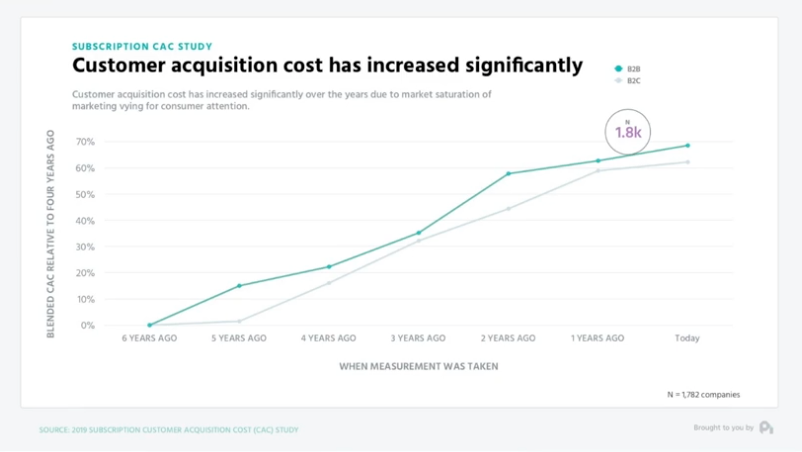
Why is that? Well, there's plenty of competition, there's plenty of SaaS companies entering the market, digital advertising is getting more expensive. Back in the day, Facebook ads didn't cost a lot, as demand increases it's only costing more.
That is one thing, I'm going to get to how that impacts the size of the customer you target.
CAC Payback model
For starters, let's make sure we are all aware of CAC and what that's all about. You may have heard of the idea of a CAC payback model. What that basically means, if you don't know is how long does it take for you to pay back the amount you paid for that customer?
If you had spent $50,000 in marketing in one month, you divide that by the number of customers you acquire in that time period to get your CAC. Whatever that costs, let's say it costs you $500 to get a new customer, how long does it actually take you to get paid back on that CAC?
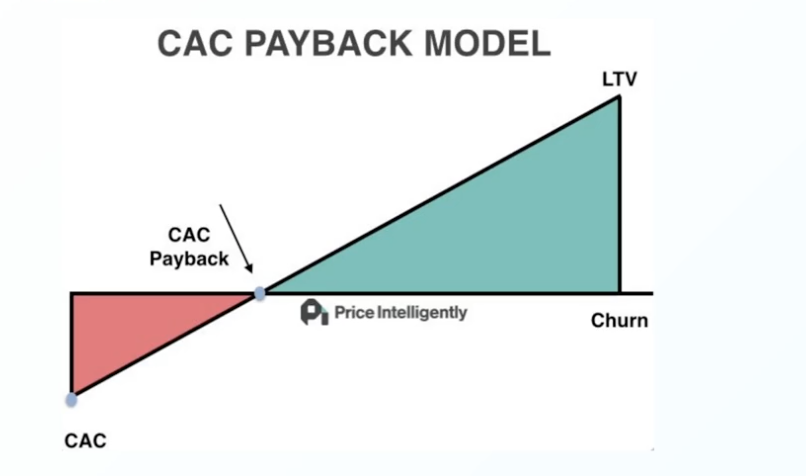
In some cases, you can have an entire first year being completely unprofitable, it might take you 12 months to even just pay back the amount it costs you to acquire the customer. That's what we talk about as far as CAC payback.
Obviously, as long as you keep a customer around, and they pay you more over their lifecycle, that's how you get your lifetime value.
You want to have a much higher lifetime value than it cost you to acquire the customer. That's point number one.
Churn
The other thing to think about is churn, we know churn is a killer of SaaS businesses, it's one of the most important metrics you need to look at.
Churn only makes it harder and harder to grow. You start to feel the impact of churn once you're getting into the 5 million ARR range. Like this image says, if you're losing 5% of your revenue each month, you're constantly chipping away at the foundation of your growth.
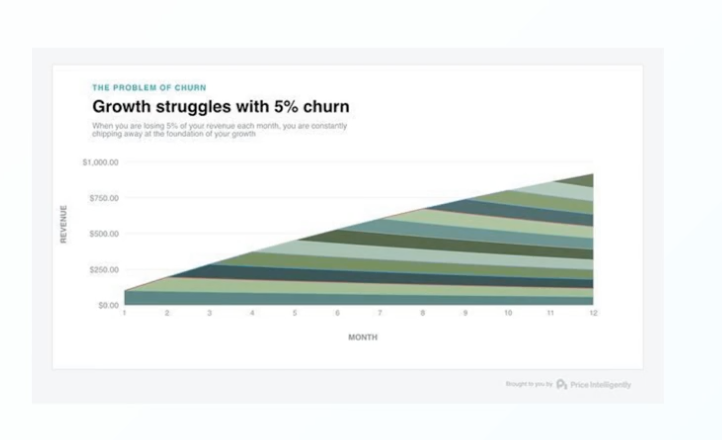
What you find when you sell to very small customers, like individuals and freelancers, a lot of SaaS companies that sell to individuals or even consumer SaaS, find the churn is very high, because individuals are a little bit fickle.
They’re always looking for new tools, they might have a sporadic need to use a tool and so they'll sign on for something for a few months, and then as soon as they stop using it, they'll cancel. It's pretty universal that churn is higher, the smaller the customer.
A big reason why companies move up-market is to primarily tackle churn, because if a big customer comes on board, and they go through a sales cycle, and they go through change management, and they've got to change processes and tools, and they get professional services to onboard them - if they invest a lot, they're less likely to churn.
How many customers does it take to build a $10 million business?
I want to draw attention to this chart, which is how many customers does it take to build a $10 million business? Some of you may be familiar with the whole concept of elephants, deers, and bunnies.
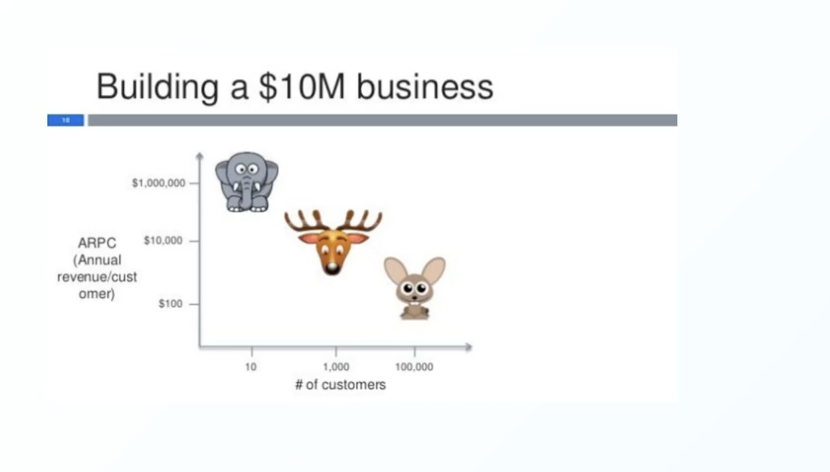
The whole idea is that if you're hunting small animals, like bunnies (not a great analogy to use if you're a lover of animals, but let's just say you're hunting bunnies) they might be easy to catch, but they don't have a lot of meat on their bones and so you need to catch a lot of them in order to feed your business.
Elephants have tonnes of meat, but they might take a whole team a year to bring down, but they'll feed you for a long time.
Deers are kind of the sweet spot, if they're going to pay you $10,000 a year, you need 1000 of those customers to build a $10 million business. That's kind of the mid market, you can also call it larger SMBs, which would pay about 10k ACV.
That's really what I'm talking about when talking about moving up-market - how do you get out of selling these tiny little customers who maybe pay you under $100 a month to a customer that's going to pay you 1000s, maybe $10,000, maybe even a little bit more?
How do you actually do that?
Proposify metrics by segment
This is our own data from Proposify. This is a breakdown of our three customer segments, you could call them small, medium, and large.
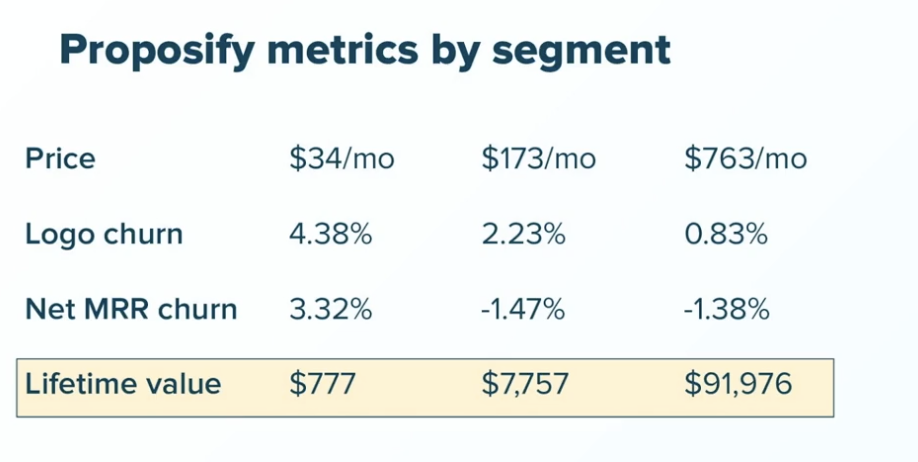
If you look at the average price point, for the smaller end customer, they pay us about $34 a month, the middle segment about $173, and then the larger segment about $763.
If I was to point back to the deers that would be kind of closer to like the deers whereas the other ones are maybe more bunnies.
What's interesting here and what I really want to focus on is the churn and how that correlates to lifetime value. As you can see, there is a drastically different amount of churn based on how much you pay so almost the more you pay, there is less churn.
Not only logo churn, and that just means how many individual customers you lose every month, what percentage of customers, but also what's the net MRR churn, how much actual recurring revenue are you losing from that churn?
As you can see, in our case, we're losing about 3.3% of our revenue from those smaller customers every month. But then once you start increasing that deal size, you get into negative churn and negative churn is like the holy grail of SaaS because it means you're actually making more from upselling and expanding your customers every month than you lose in churn.
The really important point here to look at is lifetime value changes drastically based on the size of the plan and the churn. As you can see, even though it might not seem like a massive difference between 34-173-763, based on the lifetime value, one of those customers in our small segments only actually nets out about $700 in their lifetime value.
Whereas when you get into that large tier of customer, it's actually $91,000, that's actually a very large account, because they stick around forever. This is what I'm talking about.
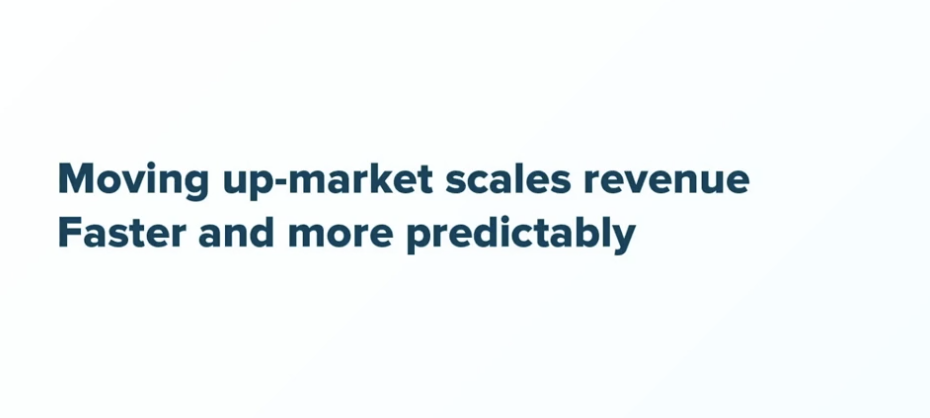
I'm not going to say that this strategy works for everybody, it's all going to be a little bit different depending on who you are. But let's say right now:
- Your SaaS business is almost entirely self-serve,
- You have maybe a great marketing funnel,
- You're able to drive tonnes of traffic to your website,
- A portion of those will sign on to a free trial, let's say get usage out of the product,
- Maybe you have a lot of automation in your marketing funnel so you are dripping on customers who sign up.
- At the end of the trial, they put in their credit card and pay.
That's kind of what we're talking about with self-serve. That's great, we still have a tonne of self-serve customers, all customers on the small and medium-sized plans are self-serve. \
But as you can see, there's a lot of value on that large tier year plan and it requires a little bit of a different strategy to get those types of customers involved.
I'm going to show you what it can actually do for your business. Again, this isn't one size fits all, every SaaS company doesn’t need to go up-market, but it is a strategy that works that a lot of famous SaaS companies that you've heard of have employed successfully.
How to move up-market
Let's say you want to do it, you're game, how do you actually get started with moving up-market? What does that mean?
Start with the three P’s
I call it the three P's, the three most important areas you want to look at for your SaaS business are your positioning, your pricing, and your product.
You can tackle these simultaneously, you don't have to start in one area, get really good at it and move on to the next - you can tackle them all at once. But it's certainly, in terms of your ability to focus, especially if you're a founder or you're involved in a lot of the operational parts of the business, hard to concentrate on more than one at once.
You'll want to make sure you have a really good team to be able to lean into.
Positioning
A quick explanation of what positioning is all about. Really, it is the foundation of how you go to market. It's involved in your sales, your marketing, and your product, all the way through your company your positioning is extremely important.
Once you know your positioning that will inform things like your branding, your messaging, and every other aspect of your business.

The mistake a lot of companies make, and actually, we made it ourselves when we went up-market was we didn't really have a clear idea of what our positioning for the larger customer segments would be.
We thought, well, let's just experiment, let's play around, let's add an enterprise tier on our pricing plan and see what happens, maybe hire a couple of sales reps. That actually slowed us down a lot, we probably could have gotten where we're at now much faster had we taken and learned all this stuff a lot sooner.
Now I want to talk about positioning a little bit.
Choose a beachhead
If you've ever read Crossing the Chasm, one of the key lessons in it is that you need to choose an area to enter the market.
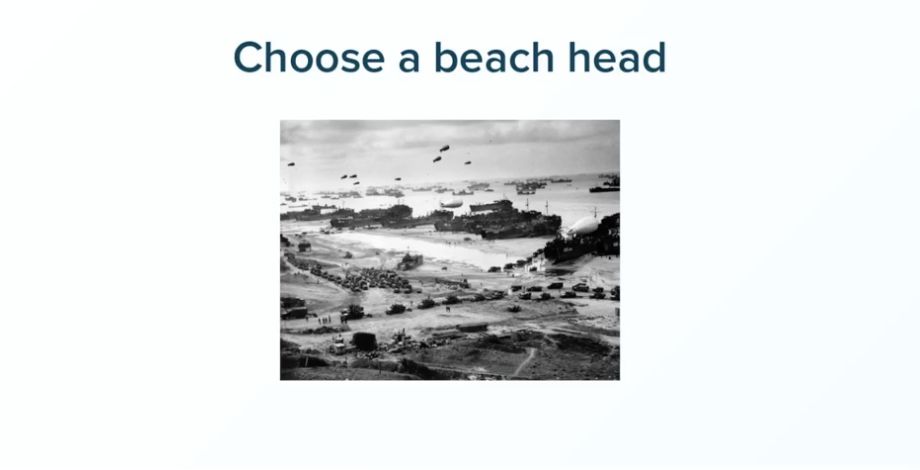
It's very hard to say we're going to be the number one solution in, let's just say, customer support software for every business. It'd be almost like trying to win a war and you want to enter it from every single angle of Europe.
You have to enter through a beachhead, that’s the analogy. You need to start somewhere and so a lot of companies have been very successful at choosing a very narrowly defined market, coming in and owning that market, being the number one solution for that type of customer, and then gradually you can spread out and tackle new markets.
But you have to start somewhere.
At Proposify we did this very well, in the early days, because for maybe two to three years, we were very aggressively targeting digital agencies and marketing agencies. A lot of our messaging was proposal software for marketing agencies. We were extremely specific.
We weren't quite as specific when we went up-market because we didn't really know who that buyer was. We knew it wasn't necessarily agencies, but we had trouble figuring it out.
Obviously Awesome
Eventually, we came across this great book by April Dunford, who you might have heard of, who wrote Obviously Awesome. It's pretty well the Bible of positioning.
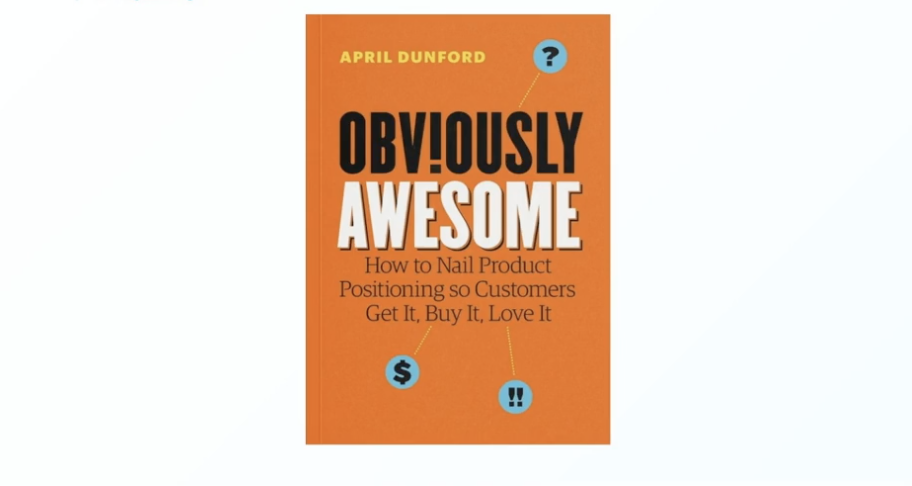
In it April lays out a framework for how to uncover your positioning, a lot of people struggle with this, how do I figure it out?
This is a screenshot from April's book that lays down the whole framework.
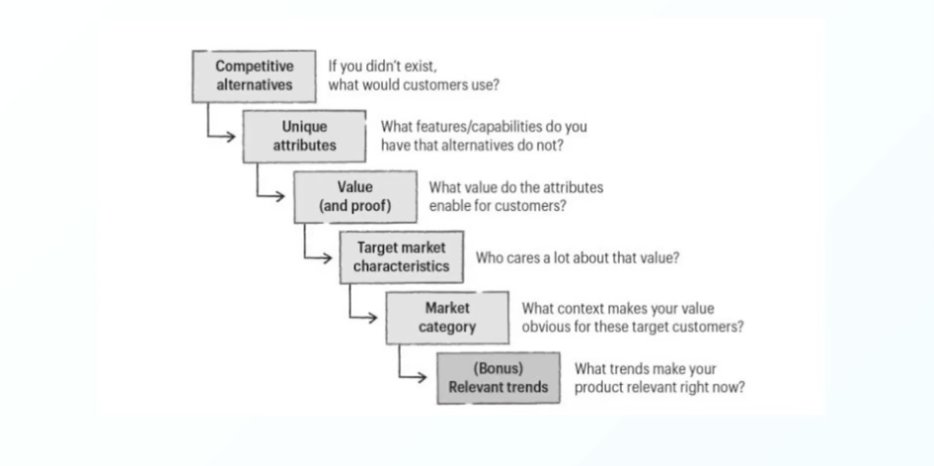
Competitive alternatives
You start off with what are the competing alternatives? In your mind, if somebody wasn't using this software, what would they use instead?
For a lot of us, we're not necessarily competing with our competitor, who we think our top competitor is, we're often competing with the status quo; Excel, Word, PowerPoint. For us in Proposify, our number one competitor is PowerPoint or Keynote, because that's how a lot of people create visual proposals today.
Sure, there are other proposal software companies out there but really, the majority of companies we come across aren't really using any specialized software, they're using regular office-type software.
Unique attributes
When you understand the competing alternatives you think, what about us makes us stand out, what features or capabilities do we have that that alternative doesn't have?
If you're competing head to head with a competitor who's very close to you, this can be a little bit dangerous because it's very easy to copy your competitors’ features and have them copy yours. But think about how does your software work fundamentally, which is very different from your competitor?
It doesn't have to be necessarily better, it just has to be different and that's the key.
Value (and proof)
Not only do we have that feature, but what value does that actually produce?
Target market characteristics
And then who cares a lot about that difference? For a lot of us, if we're trying to compete with the top SaaS companies who are number one in the space, we're not going to be able to do it on features alone.
Instead, we have to do it on differences. Maybe your software is actually much simpler than the number one used alternative. You need to lean into that difference, who actually cares the most about that difference?
Market category
Once you know that target market characteristic, then what context makes your value obvious for these target customers? That's your market category.
That could be support software, Help Desk software, CRM.
(Bonus) Relevant trends
Also, if there are any relevant trends, this is a bonus because April says you don't have to have it. But if you do happen to be in a space that's kind of sexy, or up and coming, what are some trends that you can hop on?
That'll have a limited shelf life, but it can help you.
Proposify: Old positioning
To give you an idea, this was our old positioning. When we sold primarily to really small businesses, a lot of our messaging was based on "a simpler way to send proposals, great-looking proposals, winning proposals, spit them out faster."
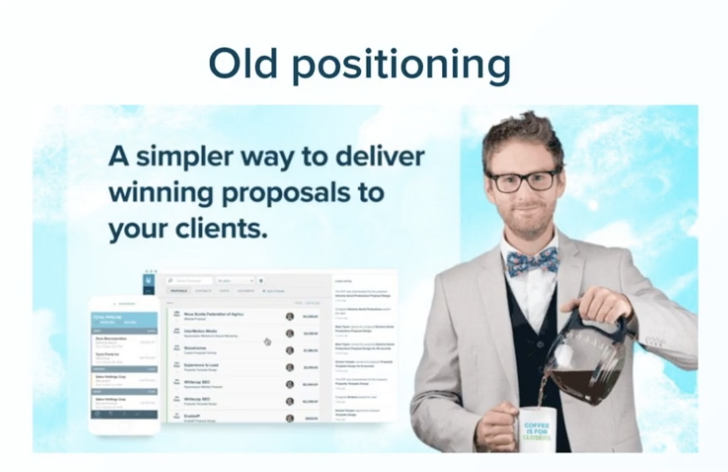
That's because we were selling oftentimes to founders or people who ran small businesses, whose time was money, they didn't like to spend a lot of time and they wanted to wow their clients. They wanted to stand out separate from the competition.
Now, our new positioning is not a polar opposite. It's not that we don't offer any of that value or any of those benefits. It's just that we don't lead with it as much.
Messaging based on positioning
When we did the work with April, we leaned into a different type of positioning. It was because when we sell these bigger customers, they're often sales leaders at more established companies, they have sales teams, sometimes they even have sales operations and they have sales support around the reps.
They don't really care all that much about great-looking proposals. They can have somebody spit out a nice-looking proposal in PowerPoint or Keynote. But what they really care about is that their deals are going out with mistakes.
A lot of times those mistakes are costing them money, they're losing out on deals, or they're underselling deals, reps discounted a deal when they shouldn't have, or they change terms and conditions when they shouldn't have, or maybe they're branding got messed up and marketing is really mad at them.
So all the work they put into their brand and their website are thrown out the window because the proposal they sent got just totally butchered by the rep who was fumbling around with copy and paste.
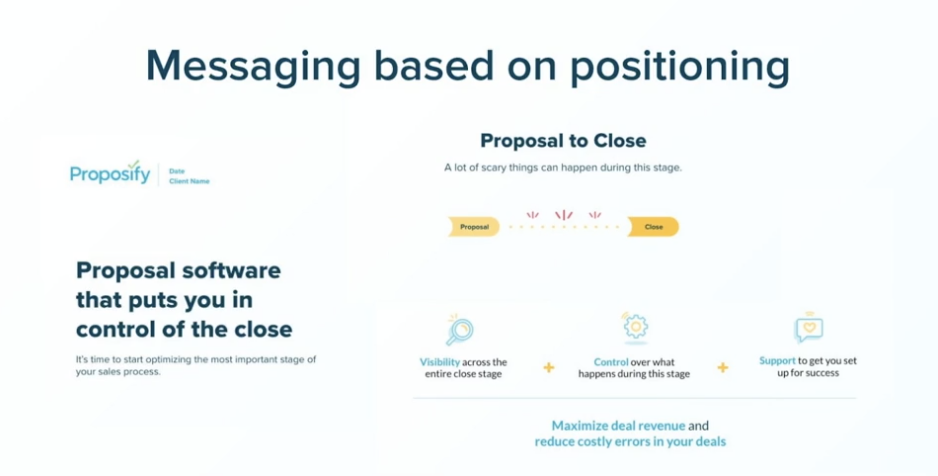
As you can see, it's the exact same product, there's no difference really in the product, but in how we position it is quite different. Now that we know that's our positioning in the market, you'll see that our messaging is now around putting you in control of the close, getting more control, getting visibility, where deals are getting stuck, where are we losing deals.
Almost giving the reps guardrails to keep them from messing up your deals. That's how we lead all of our messaging, all of our sales, to resonate with that upmarket crowd.
Hopefully, sharing this example gives you an idea that this is why positioning is so important, because we couldn't figure it out. We were running outbound campaigns and they were falling flat because what we were going to market with, the messages we were going with just weren't resonating with that group.
This work we did with April was really helpful in uncovering it. Then we tested it in the market, we ran new outbound campaigns with the new messaging and it just totally landed.
We were able to book outbound calls, we were able to get prospects on the phone, and this whole idea of control and visibility was really resonating with them.
That's number one - positioning.
Pricing
Pricing is the next big thing. We actually worked with ProfitWell, we did a year-long consulting project with them, and they helped us uncover our pricing.
When we get into pricing, sometimes it's a little bit like throwing stuff at the wall and seeing what sticks. That's how a lot of us handle pricing, "Let's just throw up a new pricing page and see who buys and we'll figure it out a few months later, did anybody buy or did they not?"
It could take you forever to uncover your best pricing that way. Doing it scientifically, doing it with ProfitWell (there are ways to do it without necessarily hiring ProfitWell, but they certainly take, take the lift-off and do it all for you) is important.
Essentially, you run surveys in the market, you pay people to answer your surveys. There's a well-known market research way, which I'll show you shortly of how to uncover your pricing.
Business impact
For starters, this is why we're doing it, what impact does it have on your business?
This data from ProfitWell shows that if you were to just increase your monetization, i.e your pricing by 1%, it would actually have a 12% impact on your bottom line compared to an equal lift in your acquisition or your retention would have a much lower impact on your company.
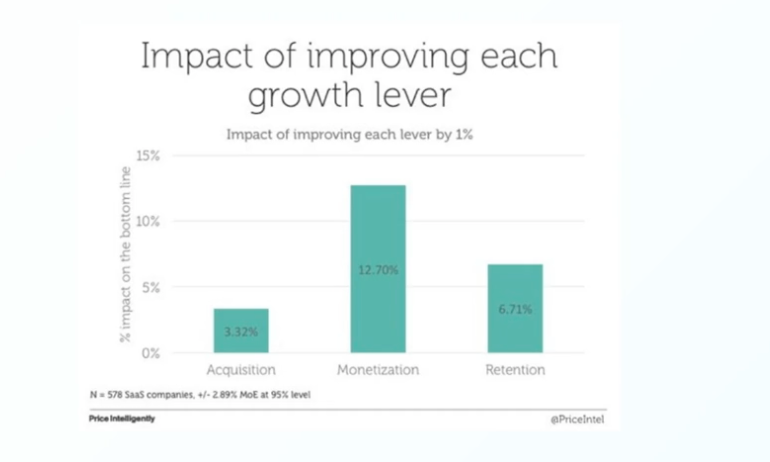
All this to say, investing in your monetization strategy is actually more impactful than even retention. But to a greater degree, it's more impactful than focusing just on acquiring new customers without first tackling the pricing component of it.
What you need to find out
Which personas are you selling to?
The things you need to find out are, who is our target buyer? But also, how do they value the product?
What do you use for your value metric?
When we talk about value metrics we're talking about, if you run a SaaS company that sells data storage, maybe that's your value metric but it also could be your seats. There are all these different ways.
There are all these different things that as the customer uses more and more and more of it, you charge them more and that's how you start to scale revenue.
We weren't able to scale revenue because we were actually charging based on the number of proposals you write. Our hypothesis was people are going to value differently - if a company is sending out 1000 proposals a month, they're going to pay more than a company that's only sending out a handful of proposals a month.
That was purely a hypothesis but as we saw, the data showed that wasn't quite how they valued it. You've probably also encountered this when you use an analytics tool. They'll often charge you based on how many sessions or how many visitors enter it. They don't actually charge you based on seat. There are different ways of doing that.
Which features drive upsells?
Also what features actually drive upsells? Because sometimes we think a feature is really valuable so we put this feature on our highest tier plan.
But actually, that doesn't really drive a lot of expansion.
How much does each tier cost?
This is how ProfitWell does it.
Price sensitivity
They use this very well-known methodology, they didn't invent it, but they use it to great effect. This methodology, instead of just asking, how much would you pay for the software? They ask:
- At what monthly price would you consider the subscription to be too expensive?
- Getting expensive, but you'd still consider purchasing?
- A bargain - what would be just a steal? And,
- What would be so cheap that you actually wouldn't buy it? Because you'd think, well, it's probably garbage if it's that cheap.
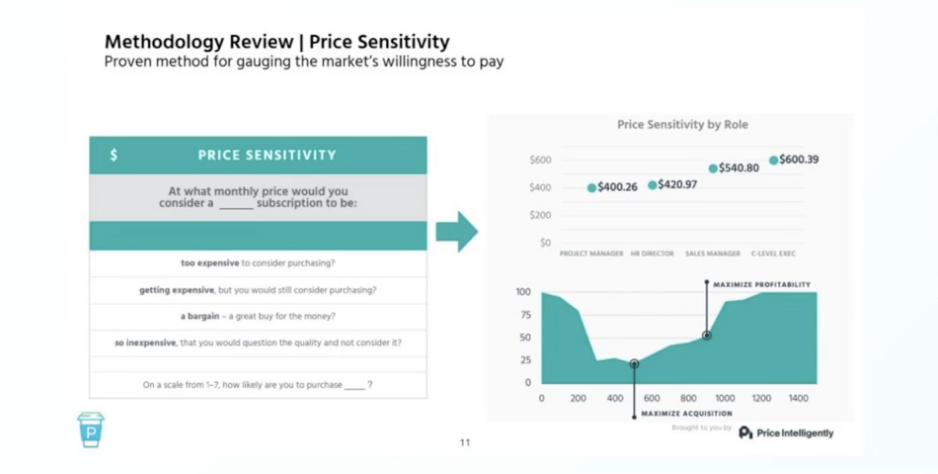
They use this pricing methodology to uncover the ideal price point.
Basically, you're not leaving money on the table by undercharging, but you're also not charging so much that it's now blowing up your demand a little bit, people are just not buying because it's way too expensive.
It's helping you find the sweet spot.
Relative preference
In terms of features, what they do is instead of just saying, would you value this feature? Would you pay more for this? It's least and most.
It's called relative preference and it's forcing them to make a decision about which is the most important thing and what is the least important thing.
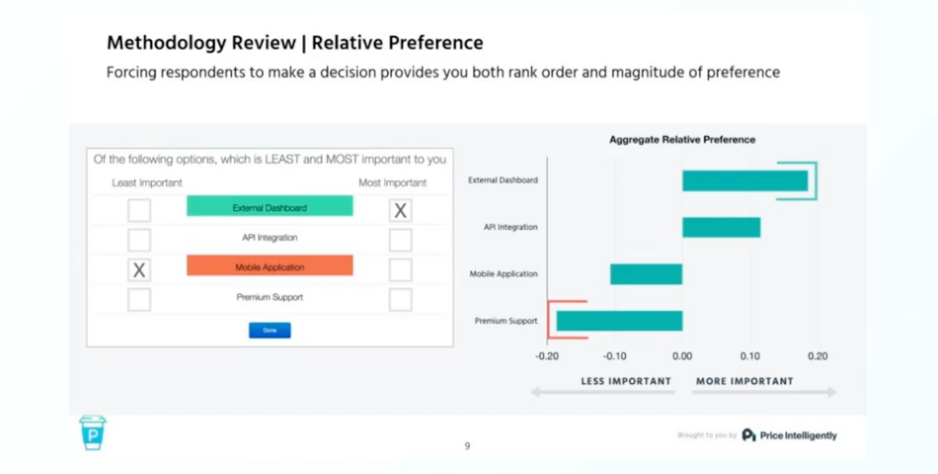
As you can see, in this example here, an external dashboard is more important for this group than premium support, they're not going to pay more for that.
The great thing too, is that you're able to break this all out by segment. When you can segment your customers and say, the small customers really care about this, but they don't care about that. Now you start to get information that you can actually put in your pricing tiers.
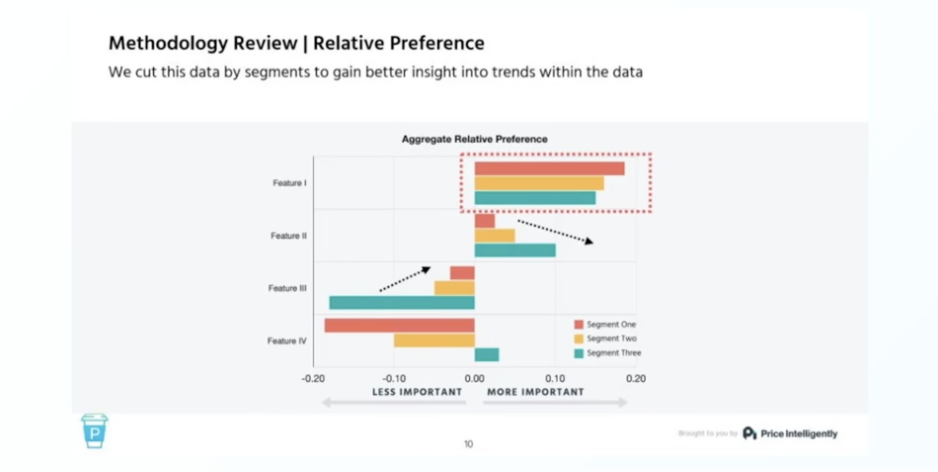
You know, for example, your largest tier customer cares the most about advanced reporting or security, they've actually said, "I will pay more for that feature because I value it the most".
Building buyer personas
What you get when you work with ProfitWell is a breakout of your personas, they'll show you the most valuable features, and their likelihood to buy as well as their willingness to pay.
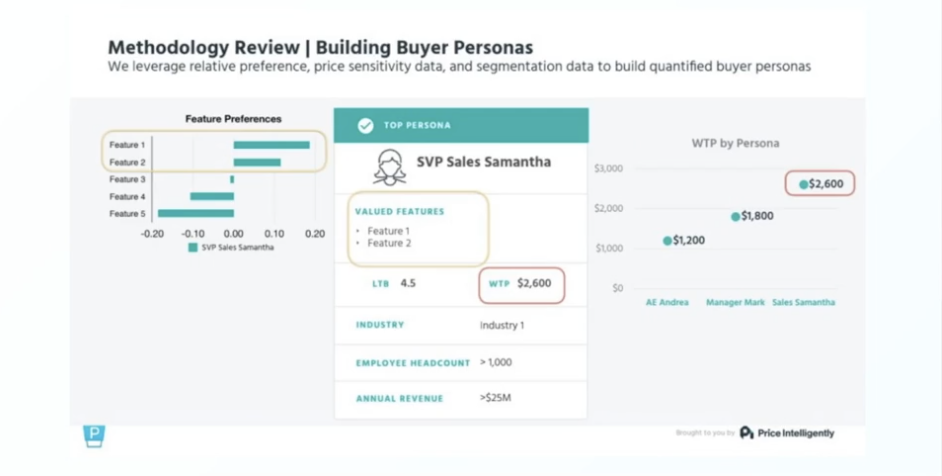
You get very clear information on how you should be charging.
Proposify: Pricing methodologies in action
When we took the information they helped us find, and we deployed it on our marketing site, and everywhere where we show our pricing, this was what we came at.
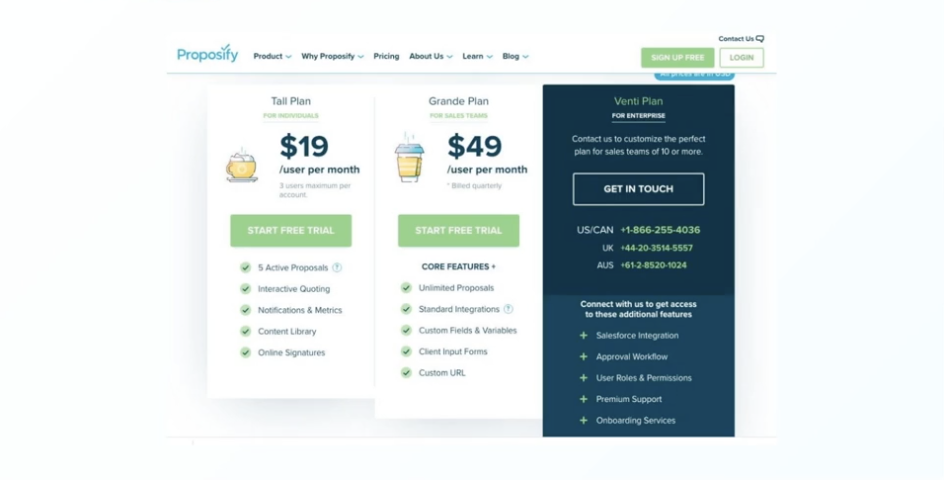
It was based on the research they had done, and it worked really, really well. We don't show what's on the Venti plan, that higher tier plan, because you have to call for pricing, and it's still a per-seat price.
That's the other thing to mention - we switched from proposals being the value metric to the per-seat price. I always hated per-seat pricing, I thought it was kind of dumb to charge per seat.
But for the customers we were going after, that's how a lot of them buy software. So they told us that's what they value so we switched. This also goes to show that you can't always trust your own gut, you have to go where the data leads you.
Our new per-seat pricing model
What we saw, if you look at this comparative when we launched the pricing, as you can see that green line was flat in terms of average deal size above a certain tier.
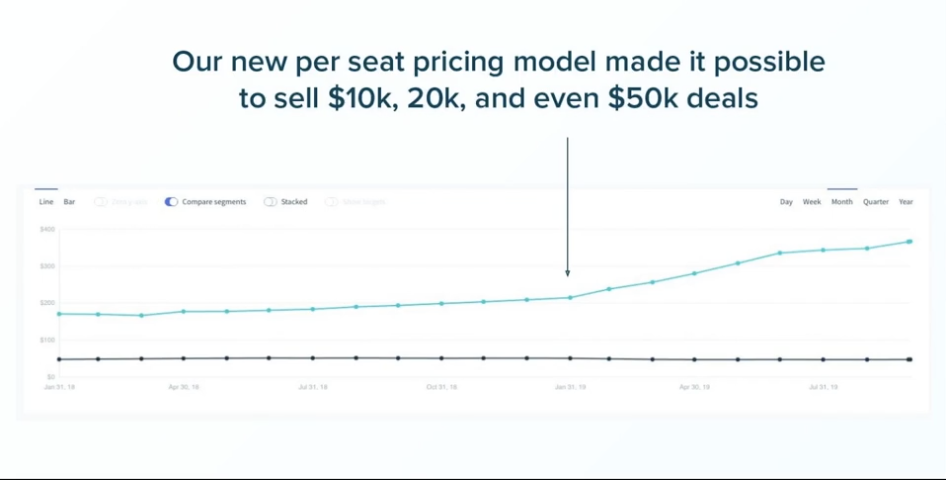
But our MRR from that segment of customer grew dramatically after we changed pricing.
Previous to that, we would never have been able to sell like a 50k a year deal because our pricing model just couldn't get there. But now we can.
For certain companies, if they have a tonne of reps that need our software, we can get that price point into the 10, 20, and 50k mark, which we never could before.
We still offer the smaller tier pricing for smaller customers though.
Product
The product is the last of these three pieces.
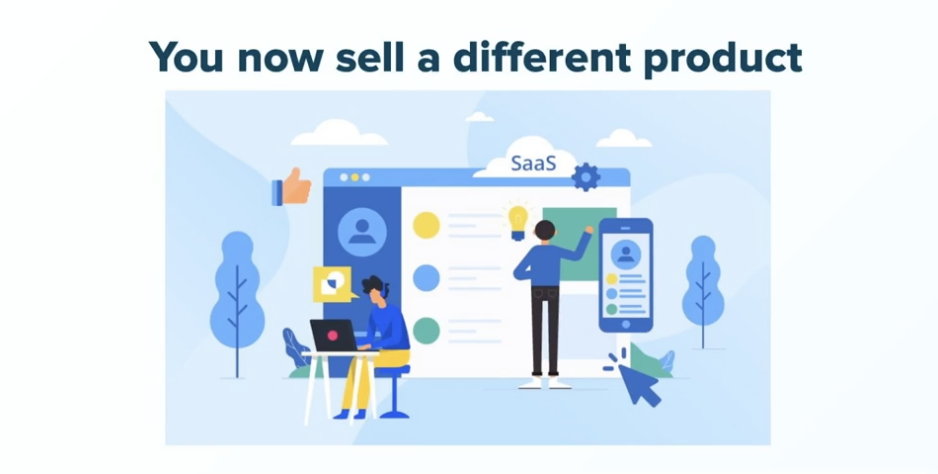
There's actually not a lot to show here because every company is going to be different. But there are a few takeaways.
Strategies
Treat the new market like a brand new startup
One of them is, if you're deciding you want to move up-market, you almost have to treat it like its own mini startup within your company. You almost have to treat it like we're actually creating a brand new product from scratch.
Specialize product teams by customer segment
To do that, it's often best to have a team that focuses 100% on that. Because much like a startup, they're going to have to do a lot of discovery, they're going to have to run tests, they're gonna have to talk to these customers and uncover the value.
It's very easy to jump into making random guesses. With product and engineering, the cycles to build new features and build on top of what you already have often take so long that it's better you don't go down the wrong road for too long.
You've got really good product management that are talking to customers and making sure that this new segment, which may look very different from your existing smaller customers, that you actually understand why they're buying and what value they have.
Because often, you'll uncover features that you just don't have, and maybe now you're competing with other SaaS companies within that larger market that you never heard of before because they're enterprise. They've got this whole feature set that you just don't have because you’ve only sold to SMBs until now.
Product team can't just focus on existing customers
Part of that is getting the product team looking at not just who you have currently because you're going to get tonnes of feedback from Customer Success about features that customers want, but there are tonnes of deals that you never won.
They came in, and they maybe talked to sales, and they didn't buy because you didn't have something. You have to be not just focusing on what your current customers want but also:
- Who talks to sales and the deal gets lost, or they go to a competitor?
- Why did they lose it?
- Was there a certain feature or something that was missing?
Win/loss analysis of deals
Win/loss analysis of your deals, you'll be amazed at how often this doesn't happen where a product team doesn't actually go into the CRM and analyse the lost deals and see why did we lose this deal?
Often it's the positioning was right, the pricing was fine, but there's this thing that they needed, and we just don't have it. That's a great place to start having your product team focus - working with the sales team.
Hire product and engineering leaders with experience in enterprise
Finally you want to make sure that, if possible, you've got product and engineering leadership that has sold to larger customers before. They've built enterprise software so there's fewer unknowns.
They know like, "Oh, security, you're going to need that". Maybe advanced roles and permissions, there's usually a certain amount of standard types of features that our larger enterprise customers want.
Bonus: building a sales team
I went through the three P's of product, pricing, and positioning, the other one is a sales team.
Let's face it, if you sell a large price product, chances are you're going to need a sales team. You don't always, there's companies like Intercom that sell really expensive products but you don't actually ever really go through sales, you just start using it and they keep jacking the price up. Eventually, you're paying a lot of money. That's really hard to do.
Usually if you want to do it well, you have to have a sales team and a customer success team. These are going to be real growth channels for you as you do this.
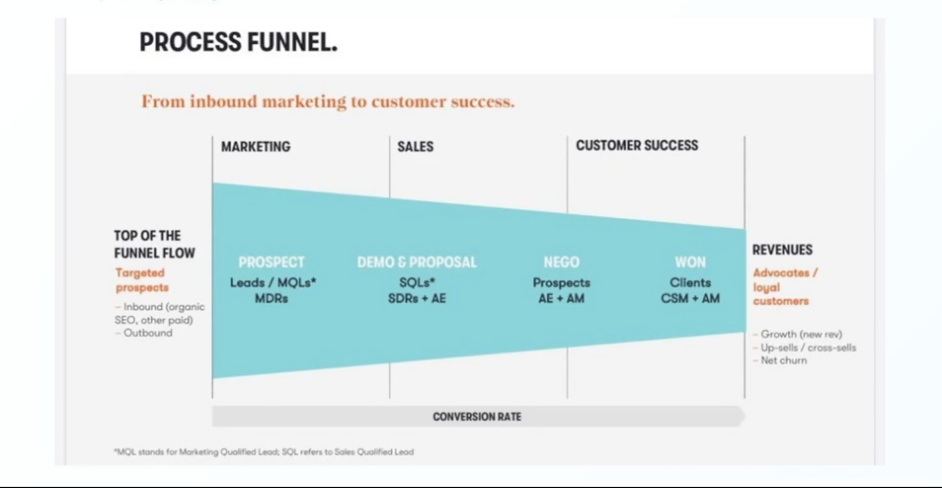
But if you're currently self serve, you probably already have that top of funnel part figured out - you know how to get leads in the door and MQLs, and you probably have a certain amount of automation. But marketing is going to change a lot once you have a sales team because they're going to be partnered together.
We usually call marketing air control or air cover. The sales reps are like the individual snipers going out and targeting individual accounts and marketing is giving help, resources, and brand awareness in those markets to help support the sales team.
Then, of course, the customer success team is in a lot of cases going to be your largest driver of growth. These are just some basic strategies to keep in mind.
Strategies
Run deals yourself as a founder to learn
If you're starting to experiment with up-market, it's really helpful to have the founder run the first few deals themselves, figuring it out, that positioning piece, the pricing piece, but also if you've done it a few times yourself, then you can train sales reps on how to do it.
Hire a VP to build the team
Once you've got a couple of sales reps who can bring in a few deals a month and close, you probably have enough of a foundation that you can now bring a sales leader in, probably a VP.
Not necessarily one that's been VP at a giant company before but somebody who knows how to really build a sales process from scratch. That's going to shave years off your learning cycle.
Begin supplementing inbound with outbound sales
The VP is probably also going to begin building an outbound cadence into the sales rep schedule. It's very tempting to avoid outbound cold calling, cold emailing, especially if you've got a pretty predictable marketing funnel.
But it can really help to build that muscle in your reps. A lot of your deals are still going to come from inbound because let's face it, it's way easier to close a deal where somebody's already aware they have a problem, they're looking for a solution. Much harder to build that demand through cold.
But it can help supplement some of those months where maybe you don't have as much inbound flow. If the sales reps are used to picking up the phone and calling, that's going to make things easier.
Get tight alignment between your sales and marketing leader
The alignment, as I said, between sales and marketing Leaders is super important and it can be very difficult to get right. But essentially, marketing and sales have to agree on what a good lead looks like.
Because sometimes you'll find a marketing leader wants to generate MQLs, it's somewhat easy to to just find leads, and then sales tosses them away and says we can't sell to this person or these companies are too small. Having sales and marketing agree on what a great fit customer looks like is key.
Customer success as a function is critical
As I said, customer success is where a lot of your growth is going to come from. Because remember when I showed you that chart that showed the retention on the larger customers and the lifetime value, that's because customer success is onboarding them, training them, optimising accounts, when accounts are coming up for renewal, they're talking to them, and often upsells happen at renewal time.
Tonnes of growth comes on the expansion side and as long as marketing and sales are good at feeding logos, essentially, to the CS team, you can have a really predictable flywheel going on.
Don’t ignore professional services
With regards to that, professional services can aid as well because some SaaS companies want to steer away from one time professional service fees thinking it's not recurring revenue, it's not going to add to our MRR.
But it's really great for retention, generate some cash, some one time fees. It's good from a cash flow perspective. But if you can sell onboarding fees and service fees to those larger customers, they often never baulk at them and it adds to retention. It means they've invested more upfront to make sure they get value out of this product.
Proposify: moving up-market
Finally, seeing how, as we started this journey of moving up-market, now those large customers still don't account for all of our revenue, but they account for a quarter of our revenue.
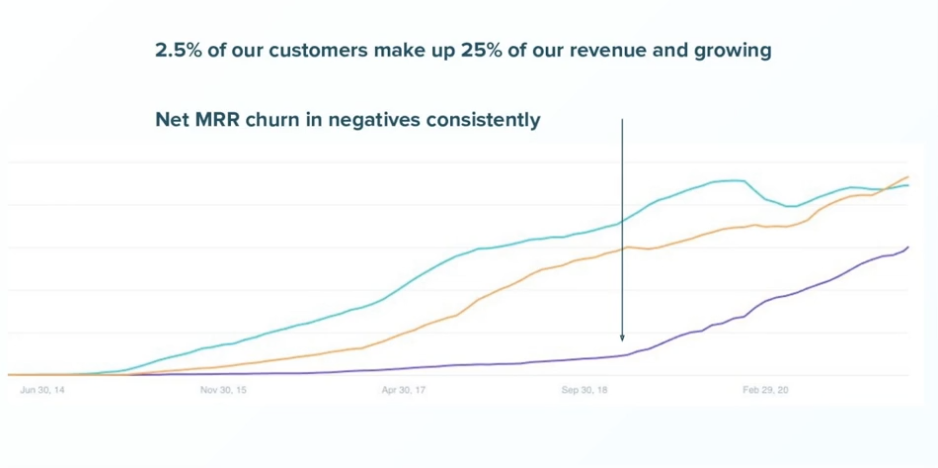
That gap is closing every month. 2.5% of our 10,000 customers make up 25% of our revenue. You can see how that segment is growing and often a lot faster.
And because the churn is better it means your economics are better, it means you can invest more in acquisition cost.
That's our journey of moving up-market.
I hope this was valuable for you. Thank you.



